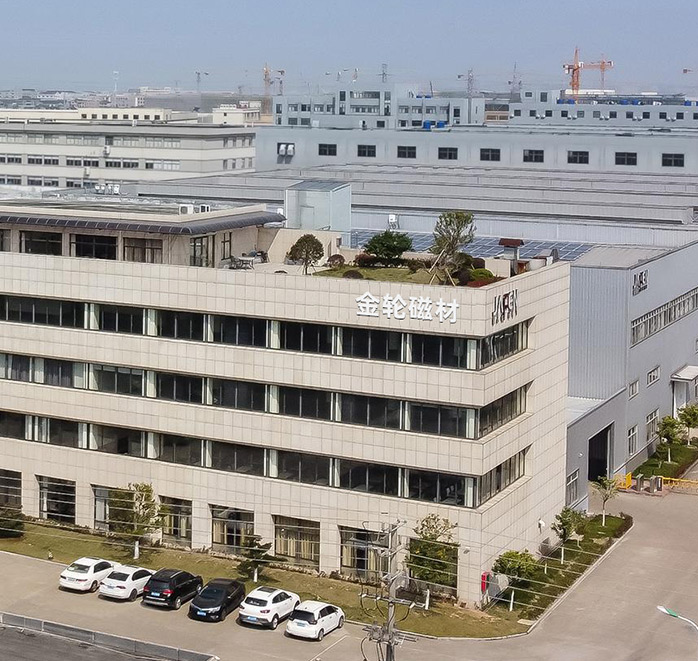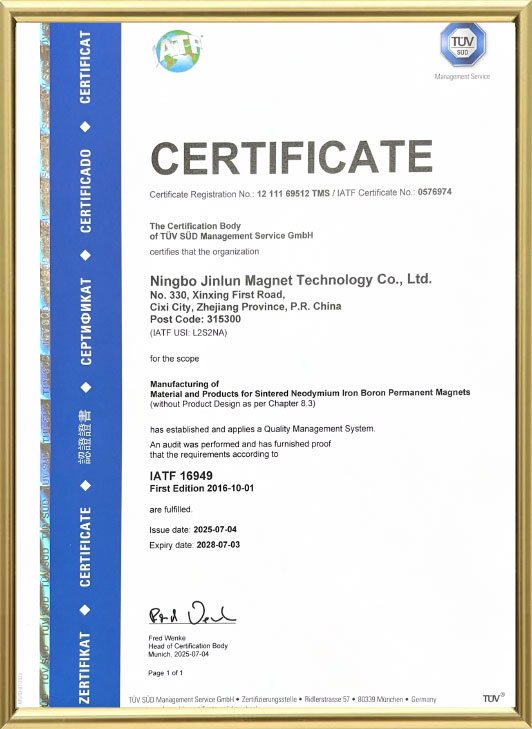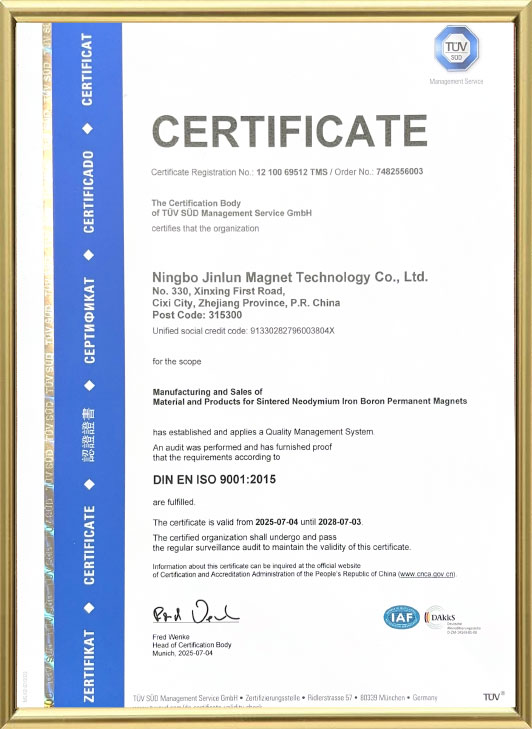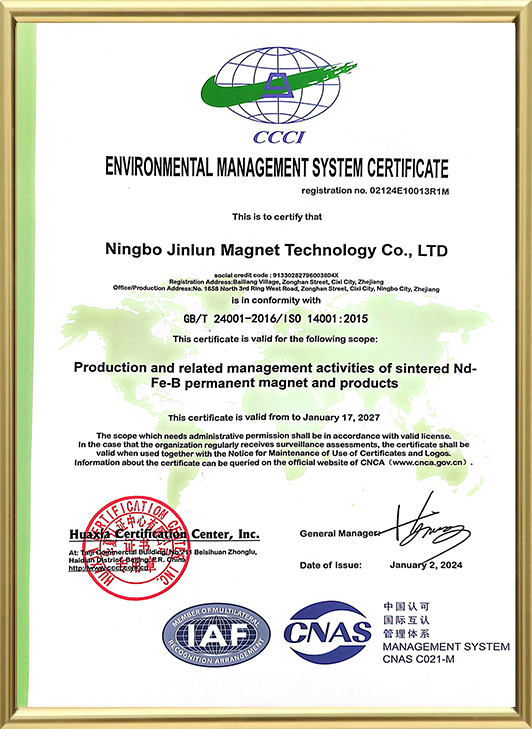Block Sintered NdFeB: Core Technologies, Applications, and Jinlun Magnetics' Production Capabilities
As one of the mainstream forms of rare earth permanent magnets, block sintered NdFeB, with its core advantages of "high magnetic energy product + customization," is widely used in industrial, new energy, and medical fields. Its performance and production process directly determine the efficiency of end-use equipment. Ningbo Jinlun Magnetics, leveraging over 30 years of industry experience and advanced production systems, has established differentiated competitiveness in the R&D, production, and customization of block sintered NdFeB.
I. Core Technologies and Performance Characteristics of Bulk Sintered NdFeB Magnets
(I) Analysis of Key Technical Parameters
The core performance of bulk sintered NdFeB magnets depends on three key dimensions: magnetic properties, physical properties, and temperature adaptability. The specific parameters and industry-standard ranges are as follows:
Magnetic performance indicators: Maximum magnetic energy product (BH) max: 263-440 kJ/m² (33-55 MGOe), remanence (Br) 1170-1480 mT (11.7-14.8 kgs), intrinsic coercivity (Hcj) 800-2800 kA/m (10-35 kOe). Hcj directly determines the magnet's resistance to demagnetization and is a key metric for selecting magnets for high-temperature applications. Physical Properties: Density 7.3-7.5g/cm³ (density must be ≥95% to ensure stable magnetic properties), Vickers hardness 500-600HV, compressive strength 8.0kgf/mm², but impact resistance is relatively weak (flexural strength approximately 25kgf/mm²), and violent collisions should be avoided during processing.
Temperature Adaptability: Conventional grades (N/M/H series) have a maximum operating temperature of 80-120°C. High-temperature grades (SH/UH/EH/AH series) can be optimized to 150-220°C by adding dysprosium and cobalt to meet different operating conditions.
(II) Key Points of the Core Manufacturing Process
Block-shaped sintered NdFeB is produced using a powder metallurgy process. Key steps directly affect the final performance:
Powdering: The molten alloy must be crushed into a fine powder of 3-5μm (particle size deviation ≤±1μm). Failure to do so can easily lead to uneven magnetic properties. Ningbo Jinlun Magnetic Materials uses a jet mill imported from Germany. By precisely controlling airflow velocity and grinding time, the powder particle size qualification rate remains stable at over 99.5%.
Sintering requires sintering at 1050-1100°C (vacuum ≤ 1×10⁻³Pa), while maintaining a controlled cooling rate (5-10°C/min) to prevent cracking in the magnets. Jinlun Magnetic Materials' vacuum sintering furnace is equipped with an intelligent temperature control system, which allows temperature deviations to be controlled within ±2°C, ensuring a density of over 96% in the resulting block magnets.
II. Ningbo Jinlun Magnetics' Block Sintered NdFeB Production and Customization Advantages
(I) Large-Scale Production Capacity Ensures Delivery Efficiency
Jinlun Magnetics has a block sintered NdFeB production line with an annual production capacity of 8,000 tons, covering the full range of "standard and custom sizes":
Regular Sizes: We can mass-produce standard block magnets ranging from 5×5×3mm to 150×100×50mm, with an average daily output of 20 tons and a shortened order delivery cycle of 7-10 days.
Small Batch Customization: We support small orders of as little as 100 pieces, suitable for applications such as scientific research and small equipment, addressing the industry's pain points of "difficulty accepting small orders and long delivery times." (II) Customized Services to Meet the Needs of Specific Scenarios
To meet the specific needs of various industries, Jinlun Magnetic Materials offers comprehensive customization:
Performance Customization: For example, we offer customized UH series block magnets for new energy vehicle drive motors. By adjusting the formula to achieve Hcj ≥ 2000kA/m and magnetic performance degradation ≤ 5% at 180°C, we also utilize a low-dysprosium process (reducing dysprosium content by 30%) to help customers control costs.
Dimension and Structure Customization: We support the processing of special-shaped block magnets (such as those with inclined holes and stepped structures). Utilizing a five-axis machining center, we achieve dimensional tolerances of ±0.01mm, meeting the specialized assembly requirements of medical devices and precision sensors.
Surface Treatment Customization: We offer four options: nickel plating (salt spray ≥ 48 hours), zinc plating (salt spray ≥ 24 hours), electrophoresis (salt spray ≥ 72 hours), and aluminum plating (salt spray ≥ 200 hours). The aluminum plating process is particularly well-suited for high-humidity environments such as wind power generation and outdoor equipment.
III. Core Application Scenarios of Sintered Block NdFeB and Jinlun Magnetic Material Compatibility Solutions
(I) New Energy Vehicles
Applications: Drive motors, EPS steering motors, and air conditioning compressor motors require block magnets with high temperature resistance and high stability (10-year service life).
Jinlun Solution: We recommend the N45SH-N50SH series block magnets, with a BH max of 36-40MGOe and an Hcj ≥ 1590kA/m. Combined with a Ni-Cu-Ni multilayer plating treatment, they resist the effects of internal motor oil and humidity. We currently supply supporting products to several automotive manufacturers.
(II) Industrial Automation
Applications: Servo motors, magnetic fixtures, and micro sensors require small, high-precision block magnets (some require a thickness of ≤1mm). Jinlun Solution: Targeting sensor needs, we produce ultra-thin block magnets measuring 8×4×2mm with a dimensional tolerance of ±0.01mm. We also offer 2-4 pole radial magnetization with a pole spacing deviation of ≤0.1mm, ensuring sensor detection accuracy of ±0.02mm.
(III) Clean Energy
Application Scenario: Wind turbine permanent magnet rotors require large, highly weather-resistant magnets (often exceeding 120×80×40mm in size).
Jinlun Solution: Large block magnets are produced through an integrated molding process, eliminating magnetic loss caused by splicing multiple pieces. The surface is treated with aluminum plating and a UV-resistant coating, passing a salt spray test of ≥200 hours and boasting an outdoor service life of over 20 years, meeting the long-term operation requirements of wind turbine equipment.
IV. Key Considerations for Product Selection and Use
Avoid blindly pursuing high-grade magnets: For example, ordinary magnetic shelves only require N35 magnets (BH max 33-36 MGOe) to meet adsorption requirements. Choosing N52 magnets will increase costs by over 40%. The Jinlun Magnetics technical team can provide free selection advice based on the application scenario.
Pay attention to installation precautions: Block-shaped sintered NdFeB magnets are fragile. Use soft clamps during installation to avoid direct impact. Also, mark the assembly direction according to the magnetization direction. Jinlun Magnetics will mark the magnetization direction on the surface of the product to reduce assembly errors.
Regular inspection and maintenance: After long-term use, magnetic performance degradation should be checked. Jinlun Magnetics offers free magnetic performance retesting services to help customers proactively identify equipment risks and ensure operational stability.
 EN
EN English
English 中文简体
中文简体 русский
русский Deutsch
Deutsch 日本語
日本語 한국어
한국어
























